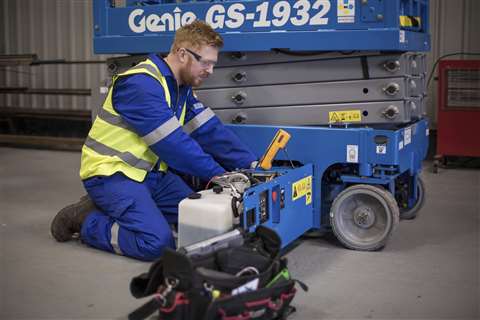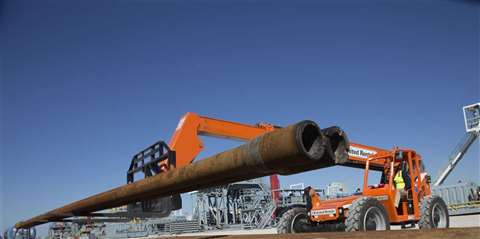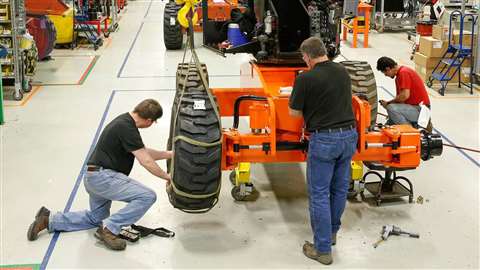Labor pains
18 February 2022
Despite what is expected to be a strong construction market this year, the industry continues to struggle with finding labor. So, what can be done to attract – and retain – employees? Lindsey Anderson speaks with some of the world’s largest rental and manufacturing firms about ways to bridge the workforce gap.
According to a recent report from the Associated General Contractors of America (AGC) and Sage, 74 percent of construction companies want to increase their headcounts this year, but recruiting, hiring and retaining personnel is becoming increasingly difficult.
Of the 1,031 participating contractors surveyed, nearly 83 percent said despite increased wages, signing bonuses, overall job security via a thriving market and other lucrative hiring incentives, acquiring new talent is still one of the biggest challenges everyone is facing.
 (Image: kerkezz/Adobe Stock)
(Image: kerkezz/Adobe Stock)
“Contractors are, overall, very optimistic about the outlook for the construction industry in 2022,” says Stephen Sandherr, CEO of the AGC.
“While contractors face challenges this year, most of those will be centered on the need to keep pace with growing demand for construction projects.”
In the AGC’s 2022 Construction Hiring & Business Outlook report, contractors are most optimistic for work within highway and bridge construction alongside transit, rail and airport projects.
The AGC attributes confidence within these segments to the $1.2 trillion Bipartisan Infrastructure bill, which industry experts say could add two million jobs per year over the next decade. Most of those jobs will be in construction.
Recruiting talent for the rental industry
Contractors aren’t the only ones being hit hard by the tight labor market; rental companies and equipment manufacturers are actively seeking candidates to fill vacancies.
“We face many of the same challenges as other industries to keep up with the demand for hiring skilled workers,” says Carson Hagar, director of recruitment services for Sunbelt Rentals.
“In particular, the demand for drivers and mechanics has outpaced the supply, so it is important to offer a competitive compensation and benefits package along with career development and a great culture to ensure you are retaining great people.”
A shortage of skilled technicians who provide maintenance, as well as drivers who deliver equipment is also a pain point for United Rentals, the world’s largest rental company.
“[Drivers] frequently interact with customers, serving as a company ambassador and providing exceptional customer service,” says Melissa Hanna, direct talent management, United Rentals.
“And since we’re local, drivers are home every night after work. They also have career paths and advancement opportunities, including advancing to roles such as dispatcher, logistics manager and operations manager, based on skills and abilities.”
On the manufacturing side, JLG says filling assembly line and painter positions has been its biggest challenge regarding the labor shortage.
“Our Shippensburg, PA facility sits just off Interstate 81,” explains Kristine Mong, JLG’s senior director of human resources.
“The stretch of Interstate 81 from Harrisburg, PA through Hagerstown, MD has seen tremendous growth in warehouse construction in recent years. With areas between these two cities being rural in nature, there are more jobs than people available to fill them.
“Long before Covid and today’s resultant work environment, finding welders has been a challenge in our area. This challenge continues.”
The same can be said for Terex.
 Service technicians are in high demand.
Service technicians are in high demand.
“Even before the labor shortages we’re experiencing this year, it was more difficult to find people for skilled trades and technical roles like service technicians and welders,” says Amy George, senior vice president and chief human resources officer for Terex.
“Beyond that, assemblers and machinists are in high demand in a number of our factories.”
Recruitment tactics
Training. Education. Technology. Job fairs. While it seems like the options are endless for companies to effectively recruit, it’s also about who they’re recruiting to.
“United Rentals is a strong believer in actively attracting and employing diverse talent,” says Hanna.
“By doing so, we can build a stronger team and better serve our customers and communities. Recruiting students about to enter the workforce from Historically Black Colleges and Universities (HBCUs) and Hispanic-Serving Institutions (HSIs) is a key focus area for us.”
Additionally, a significant portion of the United Rentals workforce comes from a military background. The company offers many roles that are a strong fit for the skills which veterans have gained through their service, Hannah explains.
“United Rentals has a work-study program that helps veterans transition into civilian work,” Hanna says.
“We partnered with Workforce Opportunity Services to develop the Service to Employment Program (STEP). The program offers 10 weeks of in-class and hands-on training, where veterans learn technical and other skills, meet with company leaders and experience what it is like to work at a United Rentals branch.”
At Sunbelt, recruitment efforts have recently focused on obtaining talent through training.
“We want our training and development programs to be a competitive advantage for Sunbelt Rentals, which is why we have heavily invested in career progression opportunities for our team members, particularly in our technician, driver and equipment rental specialist career tracks,” says David Carmichael, Sr., director of talent development and education at Sunbelt.
“We believe those programs not only allow us to attract talent but also to enrich the lives of our team members leading to higher levels of retention.”
Hagar adds, “Colleges, trade schools and military recruiting avenues have been great sources of talent for us over the years but the way we engage with those candidate pools has changed.
“Utilizing technology, social media and virtual events has become the primary tools we use every day coinciding with traditional advertising and events to attract talent.
“Once you have engaged those candidates, it is critical that you have a roadmap on how to develop them, especially when you need to attract varying levels of experience from other industries.”
JLG also has a number of ongoing programs intended to establish a network of qualified candidates for both skilled labor positions and office jobs.
 United Rentals says its philosophy is to help employees develop their skills for the job they have – and the job they want.
United Rentals says its philosophy is to help employees develop their skills for the job they have – and the job they want.
One such program is the company’s School-to-Work initiative which provides juniors and seniors an opportunity to work as assemblers at JLG manufacturing facilities to gain hands-on work experience during school days while earning high school credits.
Upon graduation, these students are eligible to apply for open roles with the company.
Another program JLG offers is its Apprentice Program, a broader approach that allows students to This apply for skilled trades, engineering or service technician apprenticeships. Students apply and then interview for the position.
Those selected work one-on-one with a JLG team member who is considered an expert in the job area of interest to the student. Apprentices generally work 20-hours bi-weekly around their standard school day, gaining credits towards graduation.
“For college level candidates, we offer seasonal, paid internships across the business, as well as year-round internships in select cross functional areas,” Mong says.
“Also, at the college level, we have pipeline offices with Shepherd University, the University of Wisconsin (Madison) and Perdue University. In collaboration with these universities, we hire select students to work with us on specific projects tied to their areas of interest.”
JLG also locally sponsors Girls in Engineering programs, robotics clubs and STEM camps.
New – and old – recruitment methods
“Specific to today’s labor shortage, we’ve used an omni-channel approach to marketing open positions, leveraging everything from traditional direct mail to radio ads and billboards, as well as newer channels like social media, which have pulled far better for us than general newspaper ads,” Mong says.
“Multi-language direct mail has been quite effective in terms of traditional approaches. However, we have also found that the more we digitize any recruitment effort the better. When individuals can easily access and apply with their phone, the more success we see tied to a specific effort.”
Something unique JLG tried during the pandemic was drive through job fairs.
 Assembly line labor is another pain point for companies.
Assembly line labor is another pain point for companies.
“These were structured much like drive-through Covid testing facilities,” Mong explains.
“A route map was established. When interested candidates arrived, they drove to a staging area where they would check in and speak to a recruiter about their work history and skills.
“If qualified, they would then drive to another area to interview with a manager. The candidate remained masked and seated in their vehicle with the manager sitting outside.
“They would then proceed to another area to continue the hiring process if an offer was extended. Any laptops or other shared electronic devices used throughout the process were sanitized between users.”
Terex also took a unique approach at how to actively reach potential employees.
“We’ve looked for additional and creative ways to advertise our open positions to potential team members, including advertising through Google and social media, mail to homes, physical billboards, and, of course, word-of-mouth referrals from our team members,” George says.
“These outreach efforts were in addition to ensuring we were continuing to provide competitive pay and incentives for our team members. This last point is something we do anyway, as a regular part of our business planning.
“But this year, with all of the changes and general tightening in the labor market, it was an area where there was even more focus than usual.”
A little more than a year ago, Terex introduced an early talent program for skilled technical talent and developed partnerships with technical colleges.
Working with those partner schools, the company donated equipment, like engines, axles and other materials, so students have hands-on opportunities to practice what they’re learning in the classroom.
Terex also worked with schools to develop and promote scholarship, internship and apprenticeship programs for service mechanics. George notes some of the company’s first interns and apprentices have already begun working in service centers this year, and the company feels excited about the quality and caliber of technicians-in-training who are coming in through these programs.
Terex also promotes its initiative, ‘Hiring our Heroes,’ to provide military Veterans a welcoming environment where they can use their valuable skills and build a career with the company.
Human resources
It’s not only important to attract the right talent, companies also want to retain the right talent.
“Terex has a strong set of six core values which we call the Terex Way,” George explains. “These values — Integrity, Respect, Improvement, Servant Leadership, Courage and Citizenship — and our absolute commitment to safety as a way of life, are the foundation of a corporate culture that strives to attract and retain a diverse workforce.
“As an employer, Terex strives to encourage every team member to achieve their career goals. We have a strong Women@Terex program to support females in our workplace. Terex also recently launched new affinity groups to meet the needs of various groups of team members across our global business.”
No matter what sector of work, one of the most important things a company can do is take time to listen to its team members.
“We regularly conduct surveys of all of our global team members with the goal of finding out what aspects of their employment they like and find rewarding, and how we can improve as an employer,” George says. “Because our vision is to be the best place to work in our industry.”
United, which also provides training, development and career planning, says it encourages a strong sense of responsibility, involvement and commitment among its employees.
Developing employees for future success
“At United Rentals, we understand that when people respect each other’s personal history, cultural experiences and fundamental rights, it makes for a better workplace,” Hanna explains.
“That’s an essential ingredient in our success. Individuals with diverse backgrounds and experiences give us perspectives that strengthens our products and services. They make us more valuable to a wider customer base and enrich the quality of our daily interactions.
“Our philosophy is to help employees develop their skills for the job they have – and the job they want. Our goal is to provide as many development opportunities as possible, knowing that learning happens not just in a classroom or online course, but through experiences, coaching and opportunity.
“We have a strong track record of promoting from within and strive to give a clear picture of what it takes to reach all levels within the company.”
Top recruitment tips from a hiring veteranRob Miner has been in staffing and services delivery for two decades. As vice president of Lawsons Global Recruitment for North America, Miner says he has created a formula for success: Learn the individual goals and objectives of each person with which you might provide services to. “I not only strive to provide valuable industry insight to the hiring managers I deal with, but I put in the time and effort to see things through their eyes,” Miner explains. “On many occasions, hiring managers have hired candidates I presented simply because I assured them that my candidate was the right person for the role. Earning that trust is my professional goal.” Here are Miner’s top three tips for those looking to recruit and retain employees: ■ The initial conversation with the candidate should focus first on learning what the candidate is looking for in their career, rather than matching skills and qualifications. The effects of the labor shortage might require companies to be flexible with their experience, skill and qualification criteria. Placing the primary focus on identifying the candidate’s desires will convey to the candidate that the organization places value on the person as an individual. ■ The additional value in the candidate-centric focus during the hiring phase is that it provides the company with a roadmap into employee retention. I have had considerable success with an “employee management plan” based upon a blending of the employee’s goals and desires with Situational Leadership (Hersey & Blanchard.) The same individual-centric focus should be applied to existing employees during periodic reviews. ■ Companies should also be aware of the counter balancing effects of recruiting and retention during a labor shortage. The stresses that fall upon many HR and talent acquisition professionals can lead to hiring focused on quantity rather than quality. The is a recipe for retention problems. Consider alternate resources that can alleviate some of the more time-consuming activities that bog down the hiring process. |
STAY CONNECTED



Receive the information you need when you need it through our world-leading magazines, newsletters and daily briefings.
CONNECT WITH THE TEAM








